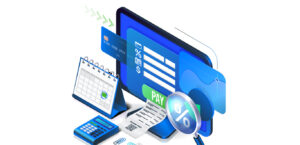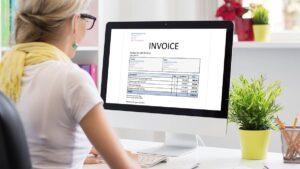So, you’re on a quest to find the perfect accounting software for your business, huh? Well, you’ve come to the right place! Choosing the right software is like finding a trusty sidekick to help you navigate the financial world with ease.
Explore the essential tips and tricks to make this decision a breeze. So, grab your map and set forth on this adventure to discover the accounting software that’ll be your financial superhero!
Ready? Go!
To choose accounting software;
1. Understand What Accounting Software Is
2. Identify Your Business Needs
3. Set A Budget
4. Choose Between Cloud Base or On-Premise
5. Research Available Options
6. Consider Ease of Setup and Use
7. Check for Essential Features
8. Consider Easy Integration
9. Check for Customer Support
10. Try free Demos
Summary
>>> MORE: How to Find Free Invoicing Software
1. Understand What Accounting Software Is
To select accounting software, understand what accounting software is.
At its core, accounting software is like a friendly guide in the world of numbers and transactions. It’s a digital tool that helps you keep track of your income, expenses, and all the financial ins and outs of your business. Think of it as a digital ledger, but way more powerful and far less dusty!
But that’s not all! It’s a treasure trove of financial insights. This digital wizard can whip up all sorts of reports and analytics, giving you a clear view of your business’s financial health. You know where your gold coins are coming from and where they’re going, all at a glance.
2. Identify Your Business Needs
To pick accounting software, identify your business needs.
Consider the nature of your business and its industry. Certain sectors may have specific accounting needs, such as inventory management for retail, project billing for service-based businesses, or tracking grants for nonprofits. Understanding your industry’s requirements helps you find software that aligns perfectly with your business needs.
Picture your business’s future—do you have ambitious plans for growth and expansion? If so, opt for accounting software that can scale along with your business, accommodating increased transactions, data, and users without any hiccups.
If your business operates across multiple locations or branches, consider how the accounting software can handle multi-location management and consolidate financial data efficiently.
For businesses dealing with international clients or transactions in multiple currencies, ensure that the accounting software can handle foreign currencies and provide accurate exchange rate calculations. Additionally, consider whether it supports multiple languages if you operate in non-English-speaking regions.
>>> PRO TIPS: Accounting Software How To Use It
3. Set A Budget
To opt for accounting software, set a budget.
Begin by assessing your business’s financial health. Understand your revenue streams, expenses, and cash flow. This analysis gives you a clear picture of how much you can allocate towards accounting software without compromising other crucial areas of your business.
Accounting software often offers different pricing models. Some providers offer subscription-based plans with monthly or annual fees, while others offer one-time purchases with ongoing support fees. Consider which pricing model aligns better with your budget and business requirements.
Look beyond the initial cost of the software. Consider the total cost of ownership, including any additional fees for upgrades, maintenance, customer support, and training. A solution with a slightly higher initial cost might offer better long-term value and fewer unexpected expenses.
4. Choose Between Cloud-Based or On-Premise
To pick out accounting software, choose between cloud based or on-premise.
Cloud-Based Accounting Software:
- Accessibility:
Cloud-based software is accessible from anywhere with an internet connection. You and your team can access your accounting data and perform tasks from various devices, making it convenient for businesses with remote or distributed teams.
- Scalability:
Cloud-based solutions are often scalable, allowing you to easily add more users, features, or storage space as your business grows. This flexibility ensures that the software can adapt to your changing needs.
- Automatic Updates:
The provider manages software updates and maintenance, so you don’t have to worry about installing new versions manually. You’ll always have access to the latest features and security enhancements.
- Lower Initial Investment:
Cloud-based solutions typically have lower upfront costs since you pay a subscription fee. This can be beneficial for businesses with limited budgets or those looking to avoid significant upfront expenses.
On-Premise Accounting Software:
- Offline Access:
On-premise software doesn’t rely on internet connectivity for access, making it suitable for businesses in areas with unreliable or limited internet access.
- One-Time Cost:
While the upfront cost of on-premise software can be higher, you’ll have a one-time payment instead of ongoing subscription fees. Over time, this might be more cost-effective for businesses with long-term plans.
- Data Backup:
Since your data is stored on your premises, you have control over the backup process and can implement your preferred data backup strategy.
5. Research Available Options
To decide on accounting software, research available options.
Start with a simple online search using keywords like “accounting software,” “best accounting solutions,” or “top accounting software for [your industry].” This provides you with a list of popular options and industry-specific recommendations.
Explore reputable software review websites like Capterra, G2, SoftwareAdvice, and TrustRadius. These platforms offer user reviews, ratings, and detailed comparisons of different accounting software products.
Visit the official websites of accounting software vendors. Here, you can find detailed information about their product offerings, features, pricing plans, and customer support. Many vendors provide free trials or demos, which allow you to test the software firsthand.
6. Consider Ease of Setup and Use
To select accounting software, consider ease of setup and use.
Opt for software with an intuitive and user-friendly interface. A well-designed layout and navigation help you and your team quickly adapt to the software and minimize the learning curve.
Look for software that offers a guided setup process or a step-by-step wizard. This feature assists you in configuring the software to suit your business needs without feeling overwhelmed.
Check if the software allows you to import data from your previous accounting system or spreadsheets. This feature can be a game-changer, especially when transitioning to new software.
7. Check for Essential Features
To choose accounting software, check for essential features.
- Invoicing and Billing:
Look for software that allows you to create and send professional-looking invoices to your clients. The ability to customize invoice templates, track payment status, and set up recurring invoices can streamline your billing process.
- Expense Tracking:
Ensure the software offers robust expense tracking features. You should be able to record and categorize expenses, attach receipts, and generate expense reports for better financial management.
- Financial Reporting:
Robust reporting capabilities are essential for gaining insights into your business’s financial health. Look for software that offers various pre-built reports and allows you to create custom reports tailored to your specific needs.
- Payroll Management:
If you have employees, payroll management features are critical. Check if the software can handle payroll calculations, tax deductions, and direct deposit functionalities.
- Tax Compliance:
Accounting software that assists with tax compliance can be a huge time-saver. Look for solutions that calculate taxes, help with tax form preparation, and stay up-to-date with tax law changes.
- Mobile Access:
Check if the software offers a mobile app or responsive web interface. Mobile access allows you and your team to manage finances on the go and stay connected.
- Data Access Control:
Look for features that allow you to control user access and permissions within the software. Limit access to sensitive financial data to authorized personnel only, reducing the risk of data breaches.
8. Consider Easy Integration
To procure accounting software, consider easy integration.
Look for accounting software that offers built-in integration with commonly used business tools, such as customer relationship management (CRM) software, e-commerce platforms, payment gateways, and payroll systems.
Check if the accounting software provides pre-built integrations with popular third-party apps. These ready-to-use integrations simplify the setup process and save you time.
>>> GET SMARTER: Invoicing Software: How It Works
9. Check for Customer Support
To choose accounting software, check for customer support.
Look for multiple support channels, such as phone, email, live chat, and helpdesk ticketing. Having various options allows you to choose the most convenient method for reaching out.
Check the support team’s availability, including business hours and whether they offer 24/7 support. If your business operates across different time zones, 24/7 support may be advantageous.
Check if the support team provides regular software updates and maintenance to address bugs, security vulnerabilities, and enhance performance.
10. Try Free Demos
To obtain accounting software, try free demos.
Some vendors offer free demos or tutorials that walk you through the software’s main features. These are helpful in getting a quick overview of how the software works.
Don’t limit yourself to just one trial. If you have shortlisted multiple accounting software options, try out their free demos or trials to compare their features and performance.
Recap
To choose accounting software, identify your business needs, set a budget, and consider cloud-based or on-premise options. Research available solutions, analyze features, security, and data protection, and try free demos for hands-on evaluation. Select user-friendly software with good customer support to make informed decisions.













